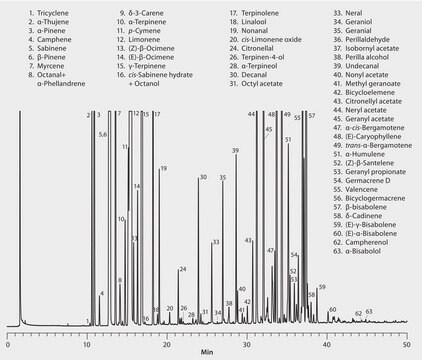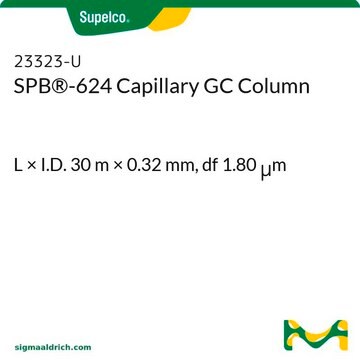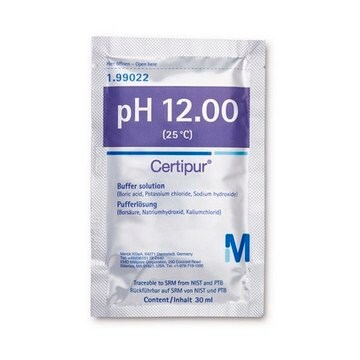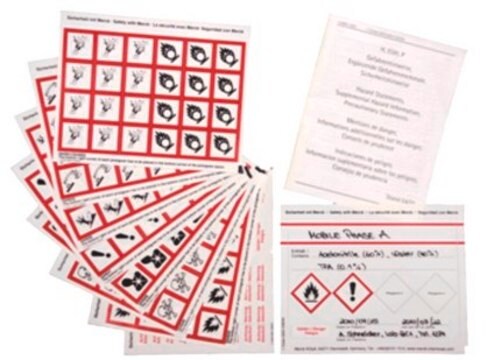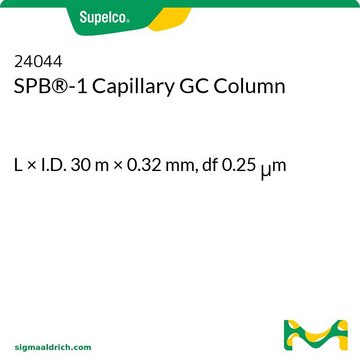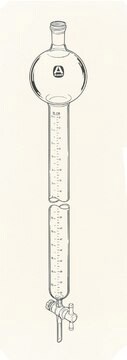24255
SPB®-624 Capillary GC Column
L × I.D. 30 m × 0.25 mm, df 1.40 μm
Synonim(y):
SPB-624, 30M .25MM 1.4UM
Zaloguj sięWyświetlanie cen organizacyjnych i kontraktowych
About This Item
Kod UNSPSC:
41115710
eCl@ss:
32119290
Polecane produkty
Materiały
fused silica
agency
EPA 524.2,0030,624,8260,OLM04.2 VOA
meets requirements for USP G43
suitable for EPA 601
Parametry
≤25-250 °C temperature (isothermal or programmed)
Wartość beta
45
df
1.40 μm
metody
gas chromatography (GC): suitable
dł. × śr. wewn.
30 m × 0.25 mm
Zastosowanie
environmental
food and beverages
pharmaceutical
typ kolumny
capillary intermediate polar
Szukasz podobnych produktów? Odwiedź Przewodnik dotyczący porównywania produktów
Opis ogólny
Application: This column is specially tested for separation, efficiency, and low bleed. It is designed for purge-and-trap analyses of volatile halogenated, non-halogenated, and aromatic contaminants from environmental samples.
USP Code: This column meets USP G43 requirements.
Phase:
USP Code: This column meets USP G43 requirements.
Phase:
- Bonded
- Proprietary
- ≤0.32 mm I.D.: Subambient to 250 °C (isothermal or programmed)
- ≥0.53 mm I.D.: Subambient to 230 °C (isothermal or programmed)
Zastosowanie
SPB®-64 fused silica capillary column may be used in gas chromatography quipped with flame ionization detector (FID) in order to measure styrene level in the blood and in the cochlear samples, in an investigation to determine the distribution of styrene in the cochlea, to monitor the hearing loss and death of cochlear cells in different regions as a result of varying styrene dosage and to analyse the relative vulnerability of cochlear cells and cell death pathways after styrene exposure as styrene is ototoxic and causes cochlear damage starting from the middle turn.
Inne uwagi
We offer a variety of chromatography accessories including analytical syringes
Informacje prawne
SPB is a registered trademark of Merck KGaA, Darmstadt, Germany
Ta strona może zawierać tekst przetłumaczony maszynowo.
Zastosowanie
Numer produktu
Opis
Cennik
Wybierz jedną z najnowszych wersji:
Masz już ten produkt?
Dokumenty związane z niedawno zakupionymi produktami zostały zamieszczone w Bibliotece dokumentów.
Klienci oglądali również te produkty
Guang-Di Chen et al.
Toxicological sciences : an official journal of the Society of Toxicology, 98(1), 167-177 (2007-04-11)
It is known that styrene is ototoxic and causes cochlear damage starting from the middle turn. However, the cellular mechanism underlying styrene ototoxicity is still unclear. In this study, rats were exposed to styrene by gavage at different doses once
Chromatograms
suitable for GCsuitable for GCsuitable for GCNasz zespół naukowców ma doświadczenie we wszystkich obszarach badań, w tym w naukach przyrodniczych, materiałoznawstwie, syntezie chemicznej, chromatografii, analityce i wielu innych dziedzinach.
Skontaktuj się z zespołem ds. pomocy technicznej
